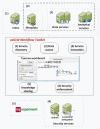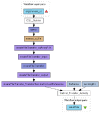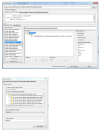CaGrid Workflow Toolkit: a Taverna based workflow tool for cancer grid
- PMID: 21044328
- PMCID: PMC3098092
- DOI: 10.1186/1471-2105-11-542
CaGrid Workflow Toolkit: a Taverna based workflow tool for cancer grid
Abstract
Background: In biological and medical domain, the use of web services made the data and computation functionality accessible in a unified manner, which helped automate the data pipeline that was previously performed manually. Workflow technology is widely used in the orchestration of multiple services to facilitate in-silico research. Cancer Biomedical Informatics Grid (caBIG) is an information network enabling the sharing of cancer research related resources and caGrid is its underlying service-based computation infrastructure. CaBIG requires that services are composed and orchestrated in a given sequence to realize data pipelines, which are often called scientific workflows.
Results: CaGrid selected Taverna as its workflow execution system of choice due to its integration with web service technology and support for a wide range of web services, plug-in architecture to cater for easy integration of third party extensions, etc. The caGrid Workflow Toolkit (or the toolkit for short), an extension to the Taverna workflow system, is designed and implemented to ease building and running caGrid workflows. It provides users with support for various phases in using workflows: service discovery, composition and orchestration, data access, and secure service invocation, which have been identified by the caGrid community as challenging in a multi-institutional and cross-discipline domain.
Conclusions: By extending the Taverna Workbench, caGrid Workflow Toolkit provided a comprehensive solution to compose and coordinate services in caGrid, which would otherwise remain isolated and disconnected from each other. Using it users can access more than 140 services and are offered with a rich set of features including discovery of data and analytical services, query and transfer of data, security protections for service invocations, state management in service interactions, and sharing of workflows, experiences and best practices. The proposed solution is general enough to be applicable and reusable within other service-computing infrastructures that leverage similar technology stack.
Figures








Similar articles
-
caGrid 1.0: an enterprise Grid infrastructure for biomedical research.J Am Med Inform Assoc. 2008 Mar-Apr;15(2):138-49. doi: 10.1197/jamia.M2522. Epub 2007 Dec 20. J Am Med Inform Assoc. 2008. PMID: 18096909 Free PMC article.
-
caGrid: design and implementation of the core architecture of the cancer biomedical informatics grid.Bioinformatics. 2006 Aug 1;22(15):1910-6. doi: 10.1093/bioinformatics/btl272. Epub 2006 Jun 9. Bioinformatics. 2006. PMID: 16766552
-
Biowep: a workflow enactment portal for bioinformatics applications.BMC Bioinformatics. 2007 Mar 8;8 Suppl 1(Suppl 1):S19. doi: 10.1186/1471-2105-8-S1-S19. BMC Bioinformatics. 2007. PMID: 17430563 Free PMC article.
-
Automation of in-silico data analysis processes through workflow management systems.Brief Bioinform. 2008 Jan;9(1):57-68. doi: 10.1093/bib/bbm056. Epub 2007 Dec 2. Brief Bioinform. 2008. PMID: 18056132 Review.
-
Evolution of web services in bioinformatics.Brief Bioinform. 2005 Jun;6(2):178-88. doi: 10.1093/bib/6.2.178. Brief Bioinform. 2005. PMID: 15975226 Review.
Cited by
-
The Taverna workflow suite: designing and executing workflows of Web Services on the desktop, web or in the cloud.Nucleic Acids Res. 2013 Jul;41(Web Server issue):W557-61. doi: 10.1093/nar/gkt328. Epub 2013 May 2. Nucleic Acids Res. 2013. PMID: 23640334 Free PMC article.
-
PAV ontology: provenance, authoring and versioning.J Biomed Semantics. 2013 Nov 22;4(1):37. doi: 10.1186/2041-1480-4-37. J Biomed Semantics. 2013. PMID: 24267948 Free PMC article.
-
SIDECACHE: Information access, management and dissemination framework for web services.BMC Res Notes. 2011 Jun 14;4:182. doi: 10.1186/1756-0500-4-182. BMC Res Notes. 2011. PMID: 21672219 Free PMC article.
References
-
- Foster I. Globus Toolkit Version 4: Software for Service-Oriented Systems. Journal of Computer Science and Technology. 2006;21:513–520. doi: 10.1007/s11390-006-0513-y. - DOI
Publication types
MeSH terms
Grants and funding
LinkOut - more resources
Full Text Sources
Other Literature Sources

